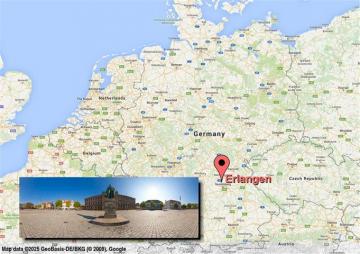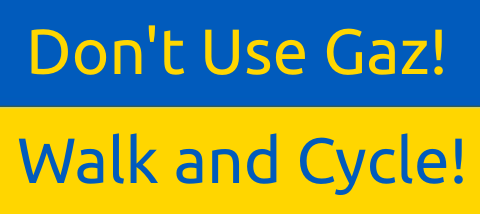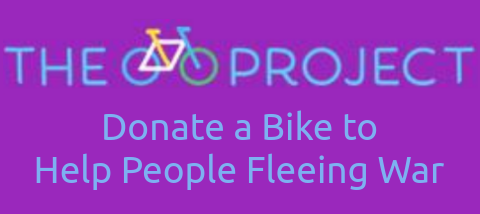
Introduction
The city of Erlangen is in the southern German state of Bavaria. Whilst Britain was following the American dream of car ownership and use, and the needs of cyclists were ignored, in Erlangen in 1972 things took a different direction. The city council took the decision to spend 2% of the city budget on cycling schemes for the next fifteen years, turning Erlangen into a Fahrradstadt (bicycle city). This was an active decision to move away from being a car-friendly city.
The city built a close-knit mesh of cycle routes, and as a result by 1979 they had achieved a cycling modal share of 16% (compare this with Birmingham City Council's "ambition" of 10% by 2033, a period of twenty years). The planning team's success was not the result of merely pushing at an open door, or of simply going out with the heavy equipment and getting on with the job. It required political leadership, because they were dealing with a car-centric city and there was a need to reassign carriageway space and restrict parking and vehicle movements, so objections would be raised. In other words, they faced the same hurdles as their Birmingham counterparts. Externally they had to promote cycling and the need for co-existence of various road users, and they had to bring on board interested parties. Internally they had to make cycling an important part of the transport planning process.
The person in charge of the planning process was the Referent für Stadtplanung (Director of Town Planning), Walter Böhlk. Although he has long since retired, he has very kindly written a short report on the planning process especially for Push Bikes, and that report is presented below (translated from German by Paul Behrens, who also took all the photos for this article except the last, which is taken from this presentation).
Creating a Fahrradstadt
Among other things, I was responsible from 1973 to 1994 for the planning and realisation of traffic systems in the city of Erlangen. For an understanding of the development of bicycle traffic in that period, it is important to know that there had been, in 1972, a combined election for the office of mayor (ie, head of the executive) and the entire city council. On that occasion, the old mayor was voted out and the party of the new mayor gained an absolute majority in the city council. The new mayor had already led his electoral campaign by bike and had aligned his entire new policy with an environmentally friendly perspective.
This radical change in the entire policy can also be gauged from the fact that bicycle traffic had not been included in previous traffic counts – in spite of the fact that bicycle traffic had always played a role in Erlangen. The reason for that was, on the one hand, that Erlangen is a university city and therefore home to many students. Another reason was that Erlangen has a great proportion of commuters; there is not a sufficient number of car parking spaces for that and those making journeys within the city limits (intra-city traffic) liked to turn to other modes of transport. Furthermore, there is the fact that Erlangen has a very flat topography. For that reason, one must, even today, make a very precise distinction between intra-city traffic and traffic transcending the city limits, when it comes to considering the distribution of traffic between various modes of transport.
It was quite obvious that the new mayor had, even during his electoral campaign, developed a clear idea of what a bicycle network for Erlangen ought to look like. At first, a working group was established in order to coordinate the different tasks within the administration. It also counted a few external members among its number. I remember a student who apparently rode his bike a lot on a daily basis and helped us with many suggestions.
Many bicycle paths were being planned and built, frequently at the expense of areas of motorised individual traffic, which had previously served moving or stationary car traffic. And some streets were completely closed to motorised traffic and only opened to pedestrians and cyclists. But this was not only a matter of bicycle lanes, but of the infrastructure as a whole. Parking spaces for bicycles were built. There was the matter of rules on giving way at intersections, of facilities for the repair of bikes, of changes in the awareness of employers and employees, of cooperation and information of the citizens. In that spirit, a cycle lane map was printed and distributed early on, which also showed the different forms of cycle lanes.
The growing bicycle network also had to be cared for and maintained. Normal road cleaning machines were not suitable for that. For the winter months, a clearing service had to be arranged.
Within the administration, too, a lot of things had to be considered: the old planners had to be familiarised with the fact that they now had to take bike traffic into account from the outset. Even the authorities that were tasked with the acquisition of land, had to get used to a new way of thinking. Extending a street by one metre so that it can accommodate a bicycle lane may not cause much more effort than extending it by one car lane, and building a cycle lane would even have been the cheaper option. That very fact, however, created challenges. On the one hand, less money could be offered to private owners of land that was to be turned into bicycle lanes, and that made them less willing to part with the relevant plots. On the other hand, there is an incentive for administrative departments to make full use of their available funds; failure to do so can result in the allocation of a reduced budget in the next financial year. From that perspective, the cheaper option is not always the most welcome one.
By way of a small anecdote, I would like to recount an incident which happened in the context of our work with the employers. There is an important employer in Erlangen who, within the city limits, has a sizeable plot with many workplaces, which is demarcated by a fence. Within that plot, the use of private means of transport is not allowed. The car parking spaces which belong to the plot, are all situated outside the fence. The way from the gate in the fence to the actual workplace has to be covered on foot. We were of the opinion that, if cycling were allowed within the plot, some employees would also use a bicycle on the way from their homes to the fence. We then learnt that there had recently been a company agreement, under which the time clock had been installed at the outer fence. The walk over the very attractively designed company plot thus turned into a paid excursion. My brief remarks indicate that I consider it of great significance for the behaviour of the population that the leadership of the city sets a good example, and that the effect is even more sustainable if there is such a measure of support within the population and the city council. I would imagine that the implementation of a new policy would be much more difficult if the city council were divided on this question and if everyone who is seen on a bike in the city would automatically be associated with a particular party.
- Walter Böhlk
The Situation Today
Unfortunately in the late 1980s budget cuts meant that no further improvements to the network could be made other than as part of other works, though money was made available for maintenance. Since 2000 additional money has been made available, but nothing significant. As a result few of the necessary improvements have been made and modal share has dropped back slightly to 15% (30% of intra-city journeys). This is a common problem; cycling proves itself to be a cost-effective, practical, and popular form of transport, but councils as a whole still think the humble bicycle cannot possibly address the transport needs of a town or city. Instead they throw money at road schemes that inevitably encourage private car usage and increase congestion and pollution, and more recently grandiose tram schemes that only benefit people whose journeys just happen to coincide with the tram line. This is true even in the Netherlands. Enlightened town planners have to keep fighting for cycling infrastructure, as indeed they still are in Erlangen today.
Woman and Child Cycling in Erlangen
Covered Cycle Parking in Erlangen
Traffic Calming Area in Erlangen
Cycle Parking at Erlangen Station
Advisory Cycle Lane in Erlangen
Segregated Cycle Path in Erlangen

A Junction in Erlangen



